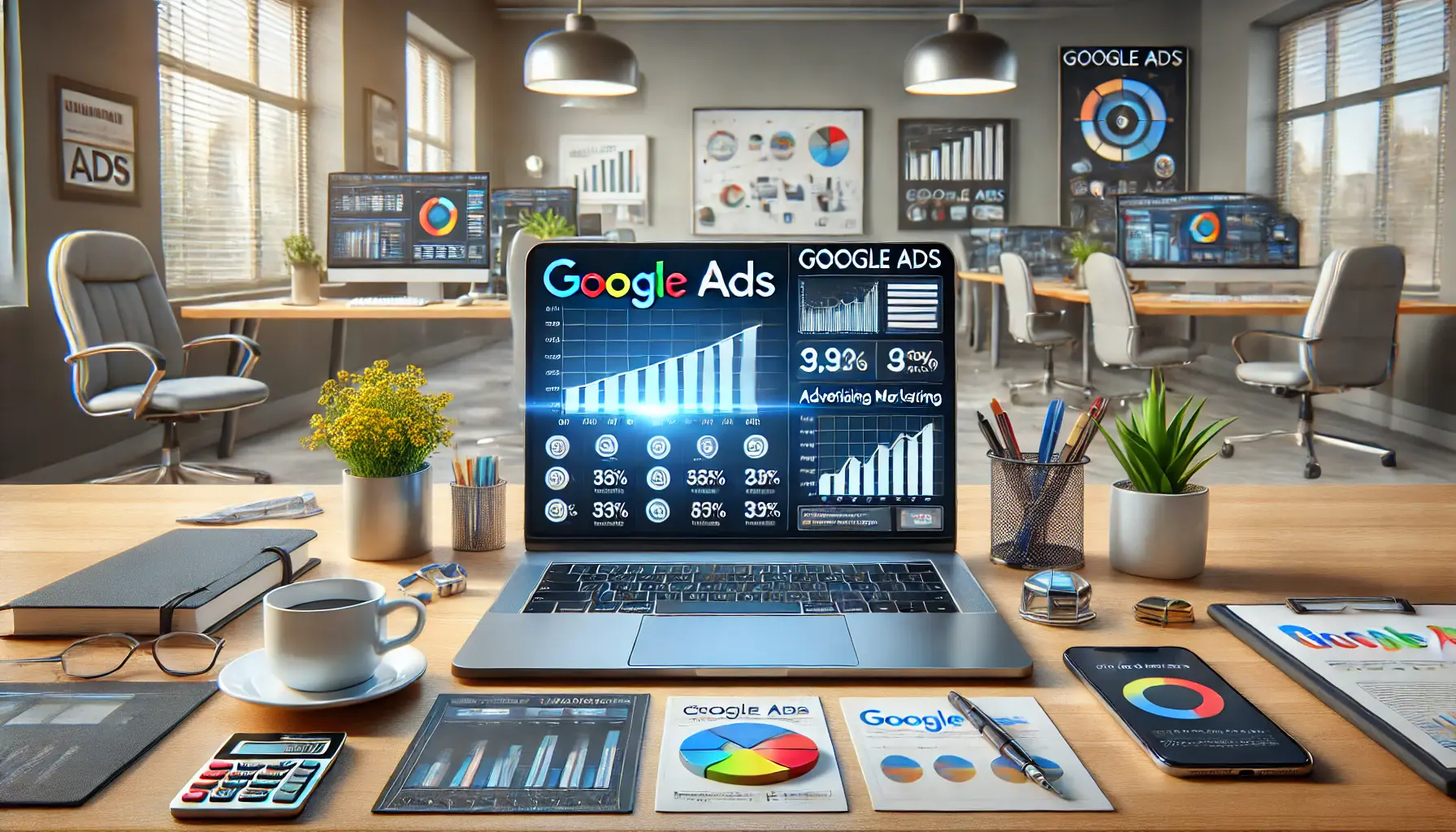In today’s digital age, understanding how Google Ads works is essential for businesses aiming to enhance their online presence.
By grasping the mechanics of this powerful advertising platform, you can effectively reach your target audience and maximize your marketing efforts.
- Understanding the Basics of Google Ads
- The Structure of a Google Ads Account
- Keyword Targeting and Match Types in Google Ads
- Bidding Strategies and Ad Rank in Google Ads
- Conversion Tracking and Performance Optimization in Google Ads
- Mastering How Google Ads Works: Key Takeaways
- Commonly Asked Questions About How Google Ads Work
Understanding the Basics of Google Ads
Google Ads is a PPCPay-per-click, a digital advertising model where advertisers pay a fee each time their ad is clicked. advertising platform where your business can run ads on Google Search and its affiliated websites.
The system works by having advertisers bid on keywords, ensuring that their ads appear each time a consumer searches for something similar.
Understanding how Google Ads works can give businesses a competitive edge.
Fundamentally, Google Ads operates as an auction in which advertisers bid for ad positions.
Your ad position is determined by several factors, including your bid amount and the quality of your ad, which Google refers to as the Quality ScoreA metric used by Google to determine the relevance and quality of ads, keywords, and landing pages..
The better your Quality Score, the higher your ad position and the lower your costs.
This is a key component in understanding how Google Ads works effectively.
Perhaps the most striking feature of Google Ads is the advanced targeting options it provides.
You can specify your target audience based on factors such as location, language, and even device type.
This level of targeting ensures your ads reach the most relevant audience, improving engagement and conversions.
By mastering these features, you can optimize how Google Ads works for your campaigns.
Additionally, Google Ads allows marketers to achieve their marketing objectives through a range of ad formats.
Some of these ad formats include:
- Search Ads: Text-based ads that appear on Google’s search results pages.
- Display Ads: Visually appealing ads that run across Google’s network of partner websites.
- Video Ads: Ads that play on YouTube and other video platforms.
- Shopping Ads: Product listings that showcase your products directly to potential customers in search results.
The basics of Google Ads provide a strong foundation for understanding how the platform works.
By learning about its structure and capabilities, you can craft targeted campaigns aligned with your business objectives and achieve meaningful results.
Google Ads operates on a pay-per-click model, enabling businesses to bid on keywords and optimize ad placements through Quality Scores and advanced targeting options.
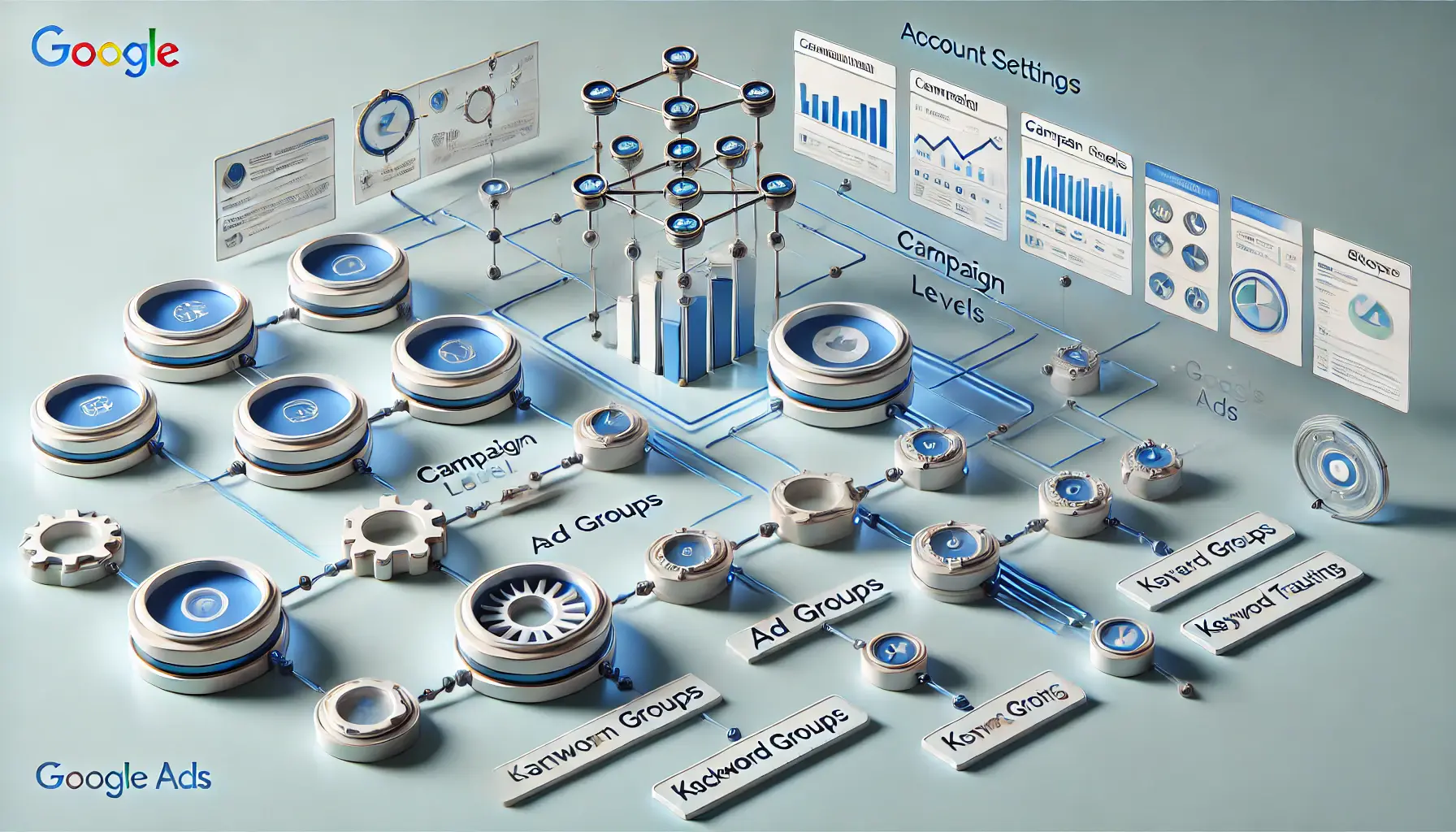
Illustration of the organized hierarchy within a Google Ads account structure, showcasing its interconnected levels and components.
The Structure of a Google Ads Account
Understanding how Google Ads works begins with grasping its hierarchical structure, which is essential for effective campaign management and optimization.
A well-organized account structure not only enhances performance but also simplifies the management of your advertising efforts.

Illustration of the account level in Google Ads, highlighting key global settings and their role in ad campaign management.
Account Level
At the top of the hierarchy is the account level, associated with a unique email address and billing information.
This level encompasses global settings such as time zone and currency, which are established during account creation and remain fixed.
Ensuring accurate settings at this stage is crucial, as they influence all subsequent campaign activities.
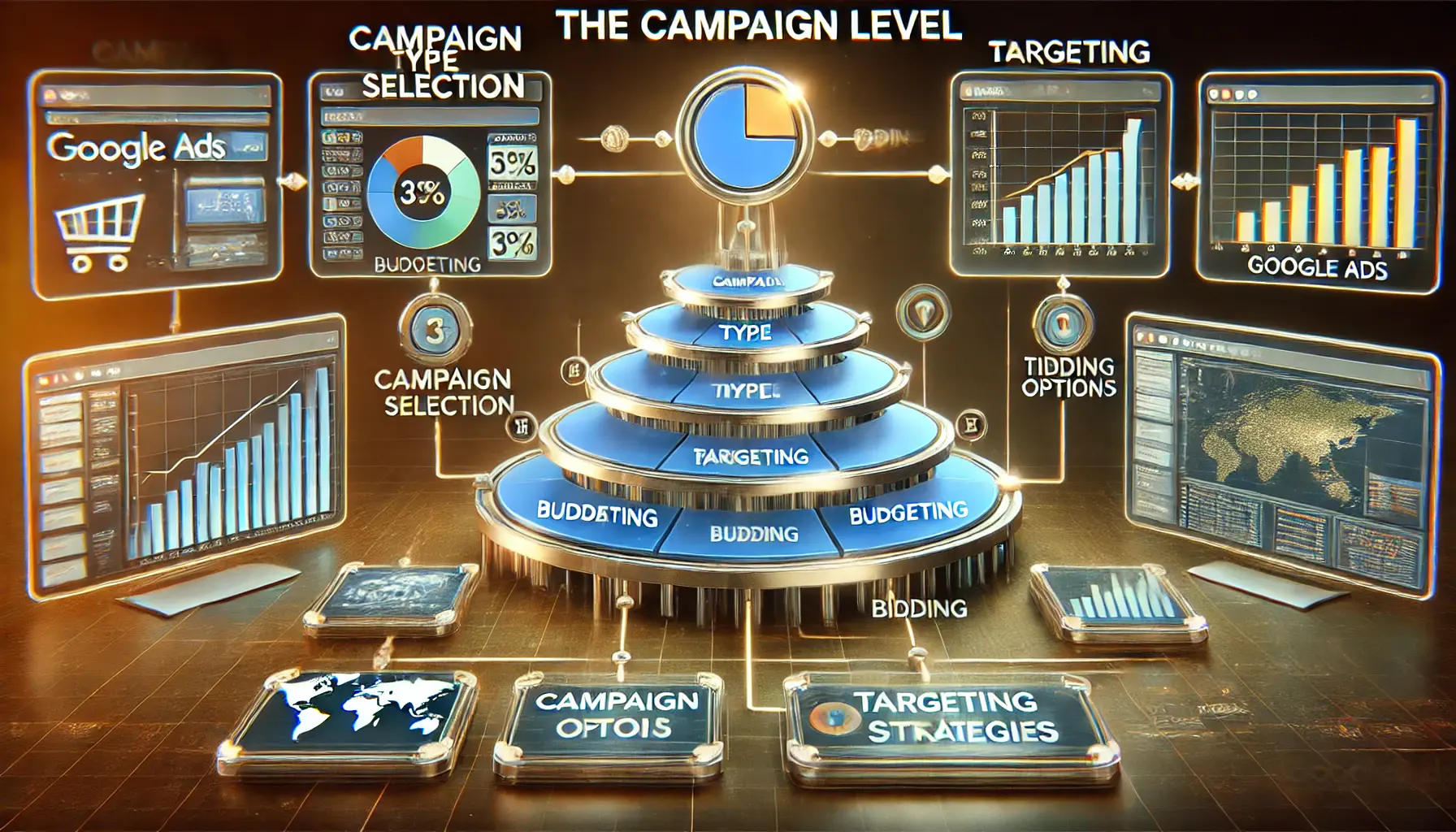
Illustration of the campaign level in Google Ads, highlighting key elements such as budgeting, targeting, and bidding strategies.
Campaign Level
Beneath the account level are individual campaigns.
Each campaign allows you to define:
- Campaign Type: Choose the right type of campaign to fit your ad goals, such as Search, Display, Video, or Shopping campaigns.
- Budget: Set a daily or monthly budget to control how much you want to spend in total.
- Bidding Strategy: Decide how you will bid for ad placements, whether manual CPC, automated bidding, or another strategy.
- Targeting Options: Identify the geographical locations, languages, and networks where your ad should appear.
Organizing campaigns around specific business goals or product lines can lead to more precise targeting and budget allocation.
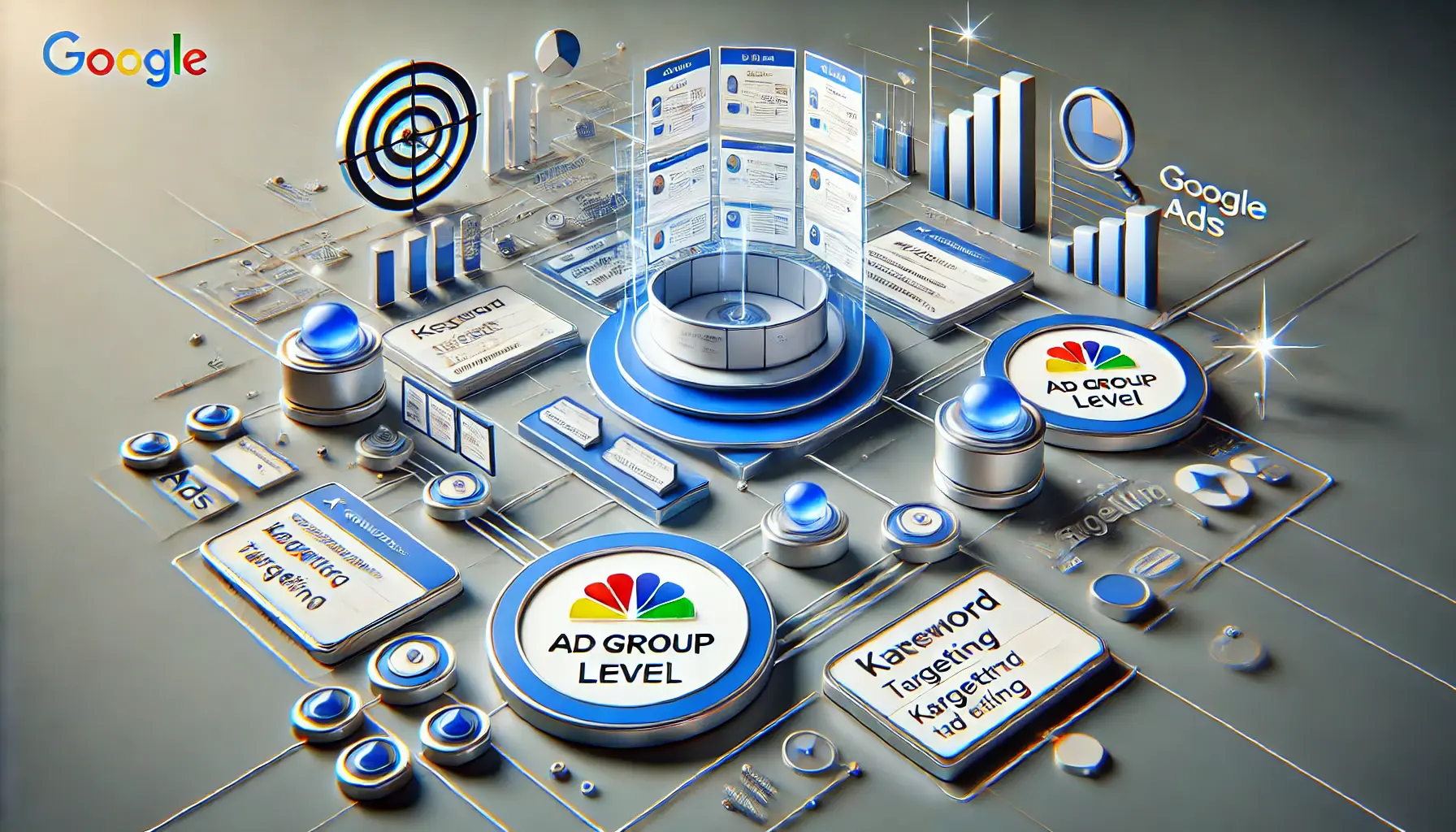
Illustration of the ad group level in Google Ads, focusing on thematic ad organization and precise keyword targeting.
Ad Group Level
Within each campaign are ad groups, which contain a set of related ads and keywords.
Structuring ad groups thematically ensures that your ads are relevant to the keywords they target, improving ad performance.
For example, if you’re advertising a range of electronics, you might have separate ad groups for ‘smartphones,’ ‘laptops,’ and ‘tablets,’ each with tailored ads and keywords.

Illustration of keyword and ad management in Google Ads, showcasing tools for keyword research, ad previews, and performance metrics.
Keywords and Ads
Within ad groups, you’ll define:
- Keywords: Specific words or phrases users might search for to trigger your ads. Conduct thorough keyword research to identify terms most relevant to your audience.
- Ads: The actual advertisements users will see. Create compelling ad copy aligned with user intent and include clear calls to action.
Tightly aligned keywords and ad content increase relevance, leading to higher Quality Scores and better ad placements.

Illustration of the importance of a structured Google Ads account, showcasing organized campaigns and efficient data flow.
Importance of a Well-Organized Account Structure
A thoughtfully structured Google Ads account offers several benefits:
- Improved Performance: Relevant ads are more likely to achieve higher click-through rates and conversions.
- Ease of Management: A clear structure simplifies campaign monitoring, reporting, and optimization.
- Budget Control: Allocating budgets at the campaign level allows for better financial management across different marketing initiatives.
By understanding how Google Ads works at a structural level, you can handle your advertising efforts more effectively, leveraging the platform’s powerful capabilities to meet your marketing goals.
A well-organized account structure enhances ad performance, simplifies management, and improves budget control, forming the backbone of successful Google Ads campaigns.

Illustration of keyword targeting and match types in Google Ads, emphasizing strategic keyword selection and targeting processes.
Keyword Targeting and Match Types in Google Ads
Understanding how Google Ads works involves mastering keyword targeting and match types.
These elements are crucial for ensuring your ads reach the right audience, thereby enhancing the effectiveness of your campaigns.

Illustration of the pivotal role of keywords in Google Ads, showing how search queries trigger relevant ads.
The Role of Keywords in Google Ads
Keywords are the terms or phrases that users enter into search engines when looking for information, products, or services.
In Google Ads, selecting appropriate keywords determines when and where your ads appear.
Effective keyword targeting aligns your ads with user intent, increasing the likelihood of engagement and conversions.

Illustration of keyword match types in Google Ads, highlighting their impact on ad visibility and targeting.
Different Keyword Match Types and Their Uses
Google Ads offers three major keyword match types, each providing a different level of control over how closely a user’s search query must match your keyword for your ad to appear:
- Broad Match: This default option allows your ad to show on searches that contain any word in your key phrase, in any order, as well as related searches. While it gives the widest reach, it may also attract less targeted traffic.
- Phrase Match: Your ad appears for searches that include the exact phrase or close variations, along with other words before or after. This match type balances reach and relevance, ensuring your ad shows for searches closely related to your keywords.
- Exact Match: Your ad is shown only for searches that match the exact term or close variations with the same meaning. This option offers the highest precision, reaching users with specific intent but with a more limited audience.
Choosing the appropriate match type is essential for controlling who sees your ads and for optimizing your ad spend.

Illustration of keyword research strategies, emphasizing the use of tools and analytics for Google Ads campaigns.
How to Perform Effective Keyword Research
Keyword research is crucial to understanding what terms your potential customers are using.
Follow these steps to guide your research:
- Use Keyword Research Tools: Utilize tools like Google’s Keyword Planner to understand search volume, competition, and keyword suggestions.
- Analyze Competitor Keywords: Examine what keywords your competitors are targeting to identify opportunities and gaps.
- Consider Search Intent: Determine whether users are seeking information, wanting to make a purchase, or comparing options, and choose keywords that accurately reflect those intents.
- Add Long-Tail Keywords: Incorporate longer, more specific phrases that often have lower search volumes but higher conversion rates due to their specificity.
As keyword research is an ongoing process, it is important to reassess your list periodically and keep it relevant to evolving market trends.
Mastering keyword targeting and match types will significantly enhance how your Google Ads work, ensuring they reach the most relevant audience and achieve your marketing objectives.
Mastering keyword targeting and match types ensures ads reach the right audience, optimizing campaign relevance and efficiency.
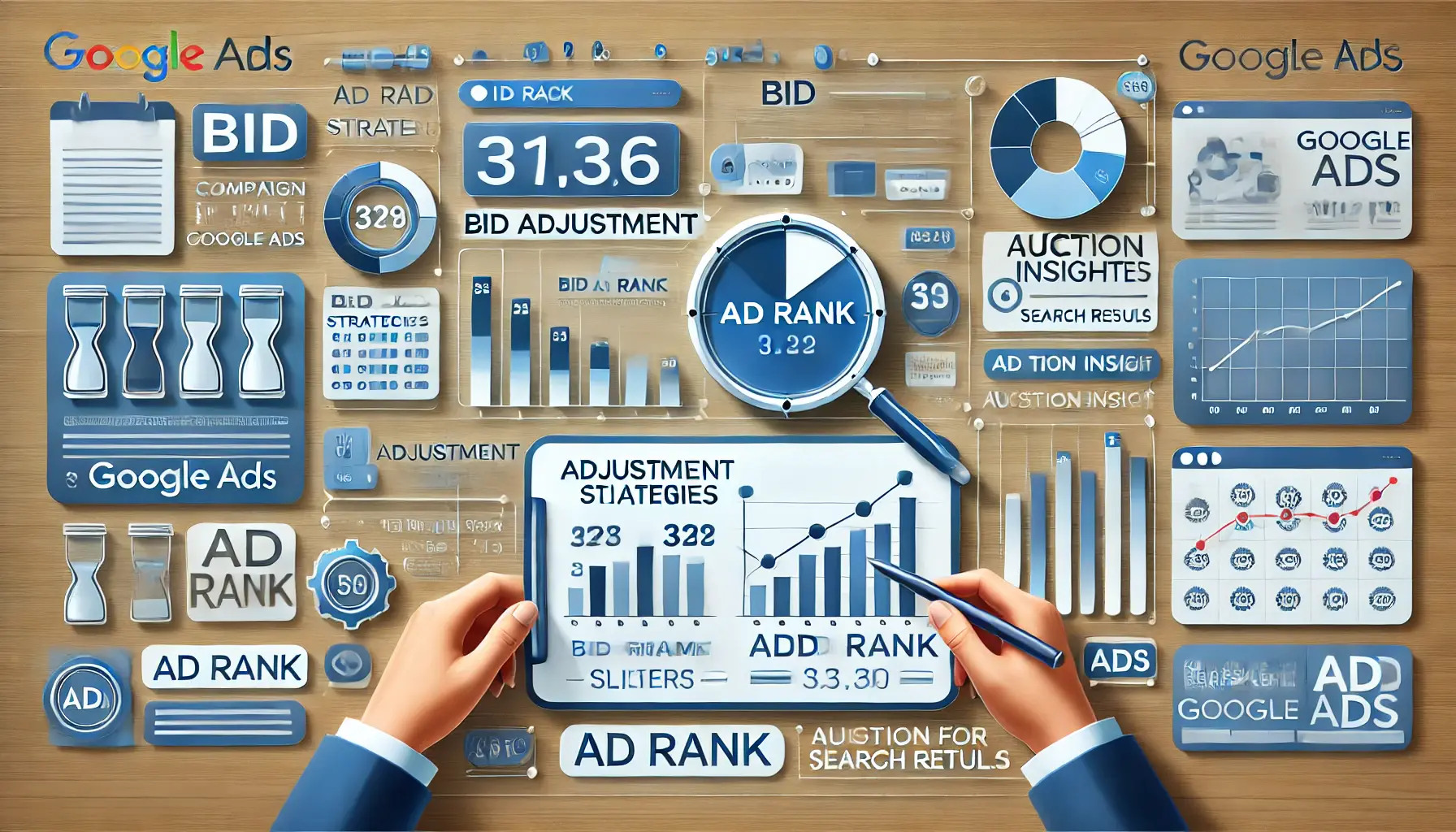
Illustration of bidding strategies and their impact on Ad Rank in Google Ads, featuring insights into campaign performance.
Bidding Strategies and Ad Rank in Google Ads
Knowing how Google Ads works requires delving deep into its bidding strategies and the concept of Ad Rank.
These components play a significant role in determining your ad’s visibility and the cost-effectiveness of your campaigns.
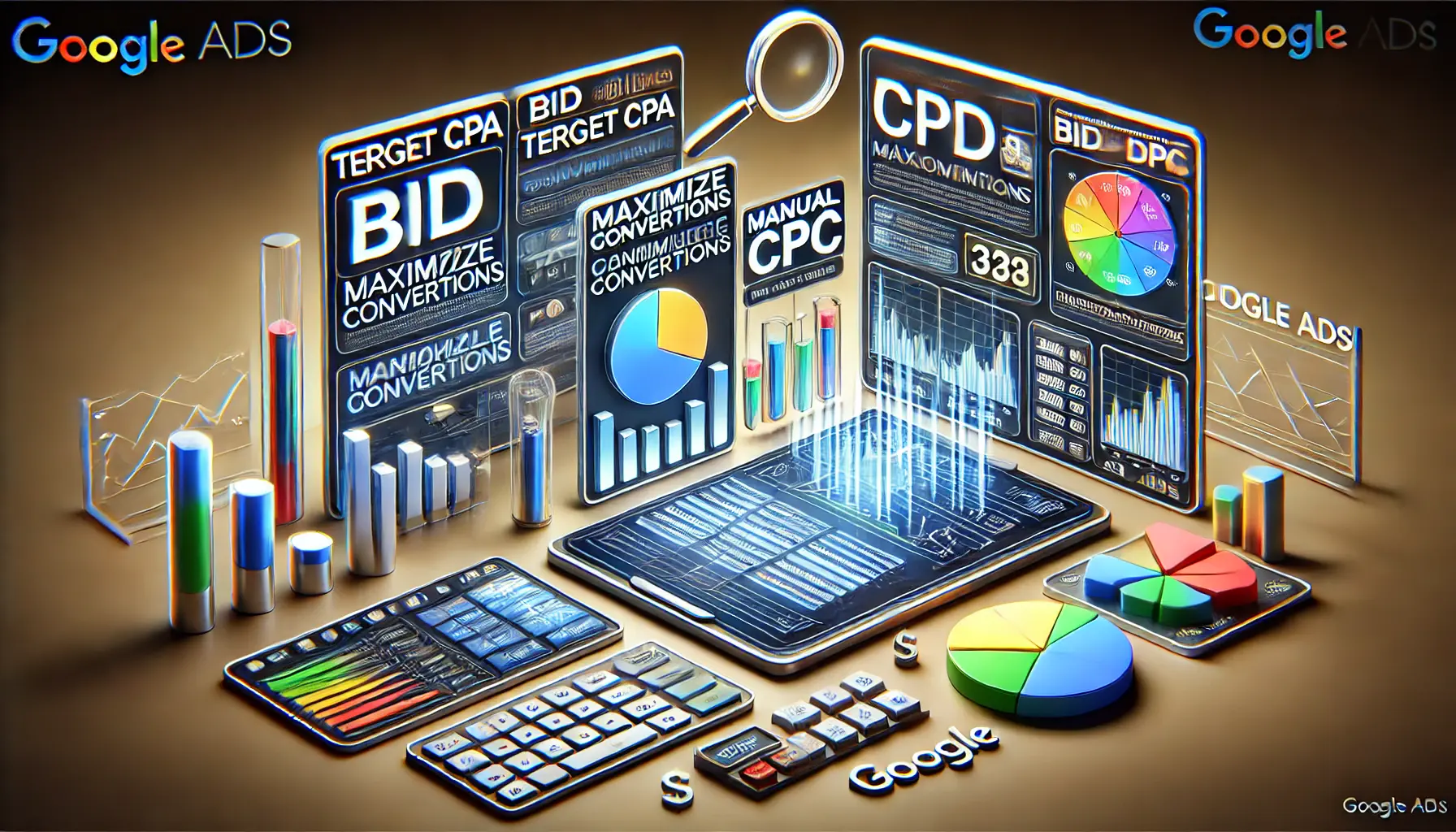
Illustration of different bidding strategies in Google Ads, highlighting their application in optimizing campaign performance.
Overview of Google Ads Bidding Strategies
Google Ads offers a range of bidding strategies for different marketing objectives.
Picking the right one can dramatically affect performance.
Here are some common strategies:
- Target CPA (Cost Per Acquisition): This strategy facilitates spending your entire budget to acquire as many conversions as possible at a specified cost per action. It works perfectly for advertisers looking to attract new customers within a fixed budget.
- Target ROAS (Return on Ad Spend): Designed to maximize revenue, this strategy sets bids to achieve a predetermined return on ad spend, making it ideal for campaigns with specific revenue goals.
- Maximize Conversions: This strategy uses your budget to get the most conversions possible. It’s beneficial for campaigns where the goal is to increase customer acquisition without a specific CPA target.
- Maximize Clicks: Helps you get the maximum number of clicks within your budget, improving site exposure and brand awareness. It’s recommended for campaigns focused on traffic growth.
- Manual CPC: Offers complete control at the keyword bid level, allowing marketers to adjust bids based on performance data for precise management.
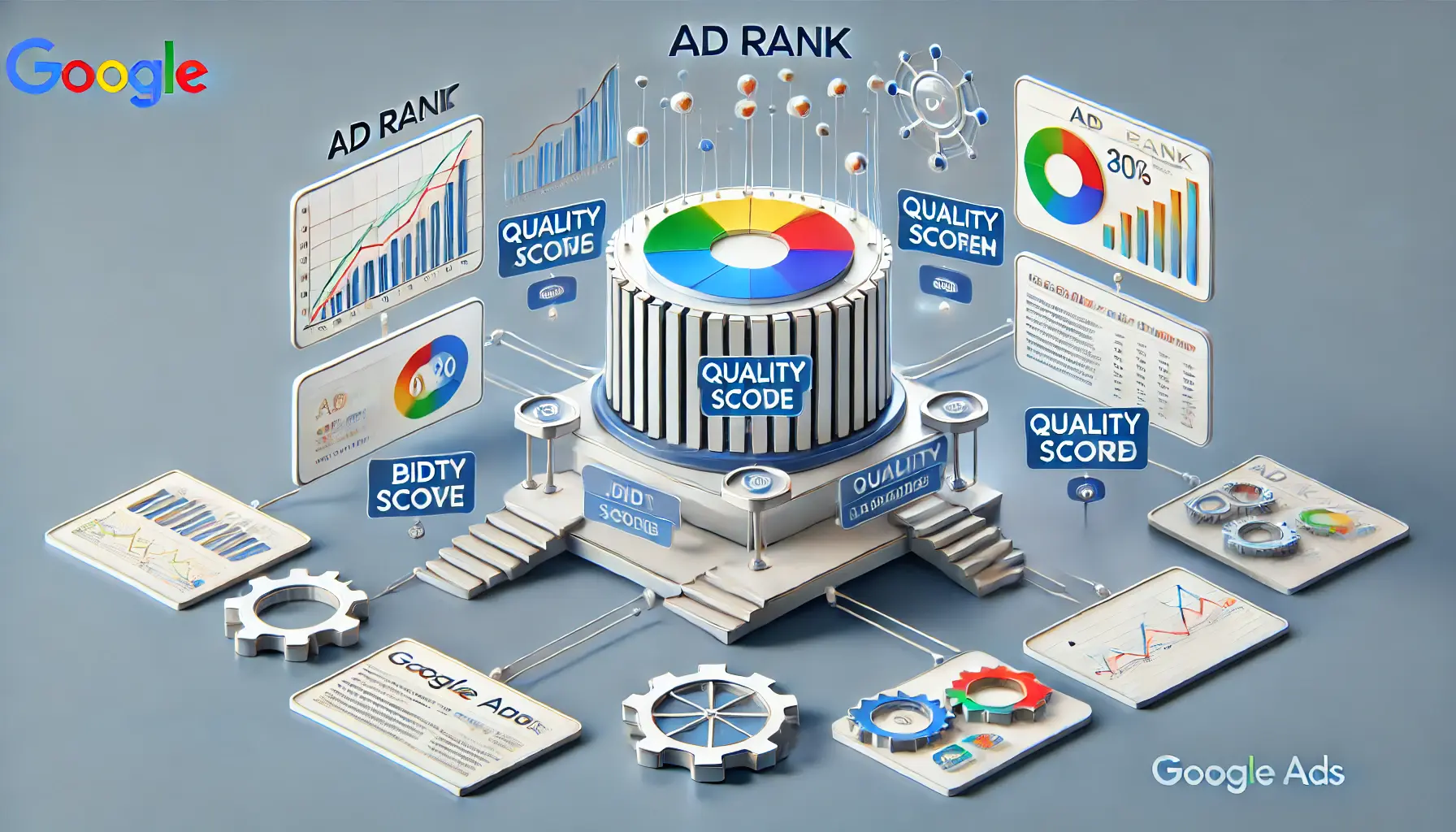
Illustration of the key factors influencing Ad Rank in Google Ads, highlighting their impact on ad visibility and cost.
Understanding Ad Rank and Its Determining Factors
Ad Rank determines the position of your ad on the search results page and is influenced by several key factors:
- Bid Amount: The maximum amount you’re willing to pay for a click influences your ad’s competitiveness in the auction.
- Ad Quality: Assessed through the Quality Score, which evaluates the relevance and usefulness of your ad and landing page to the user.
- Projected Impact of Ad Extensions: The anticipated effect of additional information, such as callouts or sitelinks, on your ad’s performance.
In general, maintaining a high Ad Rank ensures better ad positions at lower costs, translating to higher campaign efficiency.
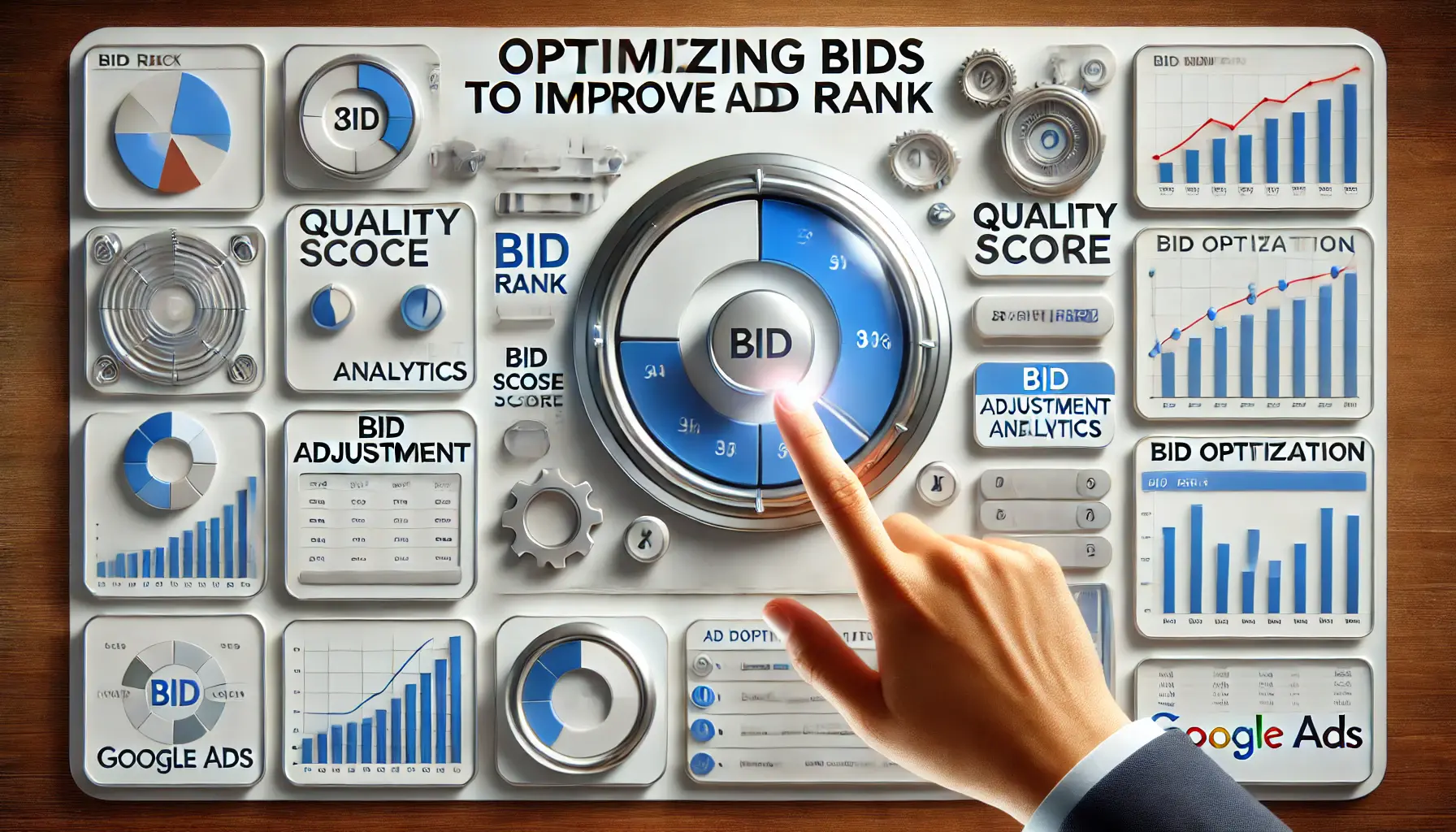
Illustration of strategies for optimizing bids to improve Ad Rank in Google Ads, emphasizing performance analytics and bid controls.
How to Optimize Bids to Get a Better Ad Rank
To improve your bidding strategy and achieve a better Ad Rank:
- Align Bidding Strategy to Campaign Goals: Match your bidding strategy directly with your priorities, whether maximizing conversions or increasing traffic.
- Improve Ad Quality: Create engaging and relevant ad copy, and ensure your landing pages are informative and user-friendly to improve your Quality Score.
- Use Ad Extensions: Enable the appropriate ad extensions to provide extra information and enhance click-through rates.
- Monitor and Adjust Bids: Regularly review performance data and make informed bid adjustments to optimize your advertising budget.
By strategically managing your bidding strategies and focusing on the factors that influence Ad Rank, you can significantly improve how your Google Ads work, leading to more effective and efficient advertising campaigns.
Choosing the right bidding strategy, like Target CPAA bidding strategy in Google Ads aiming to get the most conversions at a specified cost per action. or Maximize Conversions, directly impacts ad visibility, cost-efficiency, and overall campaign success.
Illustration of conversion tracking and performance optimization in Google Ads, showcasing key metrics and tools for campaign success.
Conversion Tracking and Performance Optimization in Google Ads
Understanding how Google Ads works involves not only setting up effective campaigns but also implementing robust conversion tracking and performance optimization strategies.
These elements are crucial for measuring success and enhancing the efficiency of your advertising efforts.
Illustration of the process of setting up conversion tracking in Google Ads, emphasizing tag implementation and analytics.
Setting Up Conversion Tracking in Google Ads
Conversion tracking allows you to monitor actions taken by users after interacting with your ads, providing valuable insight into the effectiveness of your campaigns.
To configure conversion tracking:
- Create a Conversion Action: In your Google Ads account, go to the ‘Tools and Settings’ menu, select ‘Conversions,’ and click the ‘+’ button to add a new conversion action. Choose the type of conversion you want to track, such as website purchases or sign-ups.
- Install the Google Tag: Add the global site tag to your website pages. This code enables Google Ads to register conversions from user interactions with your ads.
- Verify Tag Implementation: Use tools like Google Tag Assistant to ensure the tag is installed correctly and functioning as expected.
Accurate conversion tracking is essential for assessing the return on investment (ROI) of your Google Ads campaigns and making informed optimization decisions.
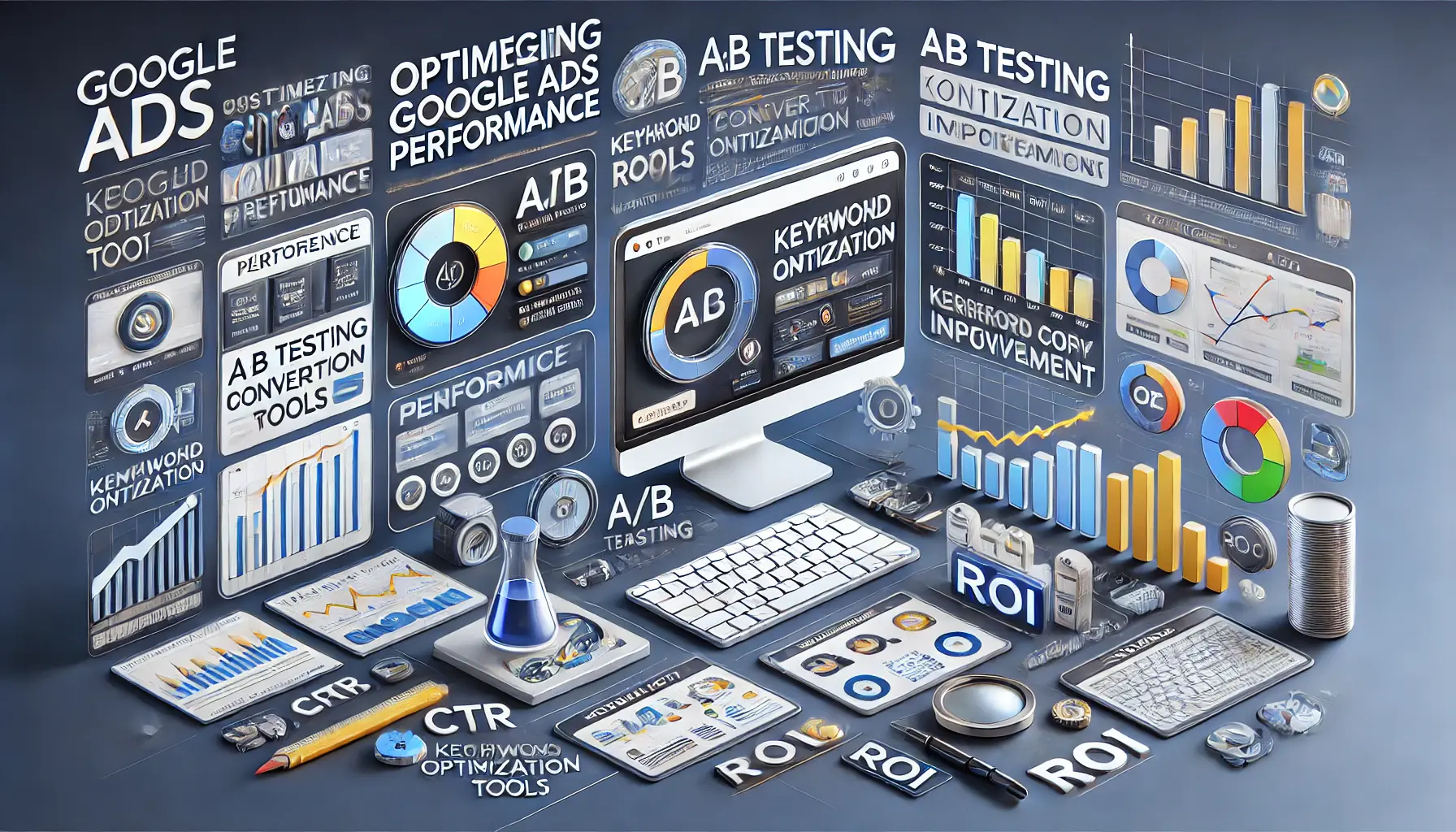
Illustration of optimization strategies in Google Ads, focusing on tools and analytics for improving campaign performance.
Strategies for Optimizing Google Ads Performance
Enhancing the performance of your Google Ads involves several key strategies:
- Keyword Optimization: Regularly review and update your keyword list to ensure alignment with user search intent. Add negative keywords to exclude irrelevant traffic and focus on high-performing terms.
- Ad Copy Improvement: Create impactful ad copy that resonates with your audience. Use A/B testing for headlines and descriptions to identify the most effective messaging.
- Landing Page Optimization: Make landing pages user-friendly, fast-loading, and aligned with the promise of your ads. A seamless user flow can significantly boost conversions.
- Bid Management: Leverage automated bidding strategies, such as Target CPA or Maximize Conversions, to efficiently manage bids. Periodically review and adjust bids based on performance data.
- Ad Scheduling: Analyze performance data to identify peak engagement times and adjust your ad schedule to align with those periods.
Implementing these optimization strategies can lead to improved ad performance, higher conversion rates, and a better return on your advertising investment.

Illustration of Performance Max campaigns in Google Ads, emphasizing AI-driven optimization and creative asset management.
Utilizing Performance Max Campaigns
Performance Max campaigns use Google’s AI to optimize performance across multiple channels.
To maximize their effectiveness:
- Provide High-Quality Creative Assets: Upload a variety of images, videos, and ad copy to allow the AI to generate engaging ads tailored to different audiences.
- Set Clear Conversion Goals: Define specific objectives to guide the AI in optimizing toward your desired outcomes.
- Monitor and Adjust: Regularly review performance reports and make data-driven updates to asset groups, targeting, and bidding strategies.
By effectively leveraging Performance MaxA Google Ads campaign type that uses AI to optimize ads across multiple platforms. campaigns, you can expand the reach and efficiency of your Google Ads, achieving better results across multiple platforms.
Incorporating strong conversion tracking and strategic optimizations are fundamental to understanding how Google Ads works and achieving success in your digital advertising efforts.
Accurate conversion tracking and continuous performance optimization are critical to measuring ROI and improving the effectiveness of Google Ads campaigns.

Illustration of the key takeaways for mastering Google Ads, emphasizing strategic planning and optimization.
Mastering How Google Ads Works: Key Takeaways
Google Ads is a powerful advertising platform that empowers businesses to reach their target audience, drive traffic, and achieve measurable results.
Understanding its mechanics is essential for leveraging its full potential.
From keyword targeting to performance optimization, each aspect plays a critical role in creating successful campaigns.
Below is a summary of the key insights covered in this article.
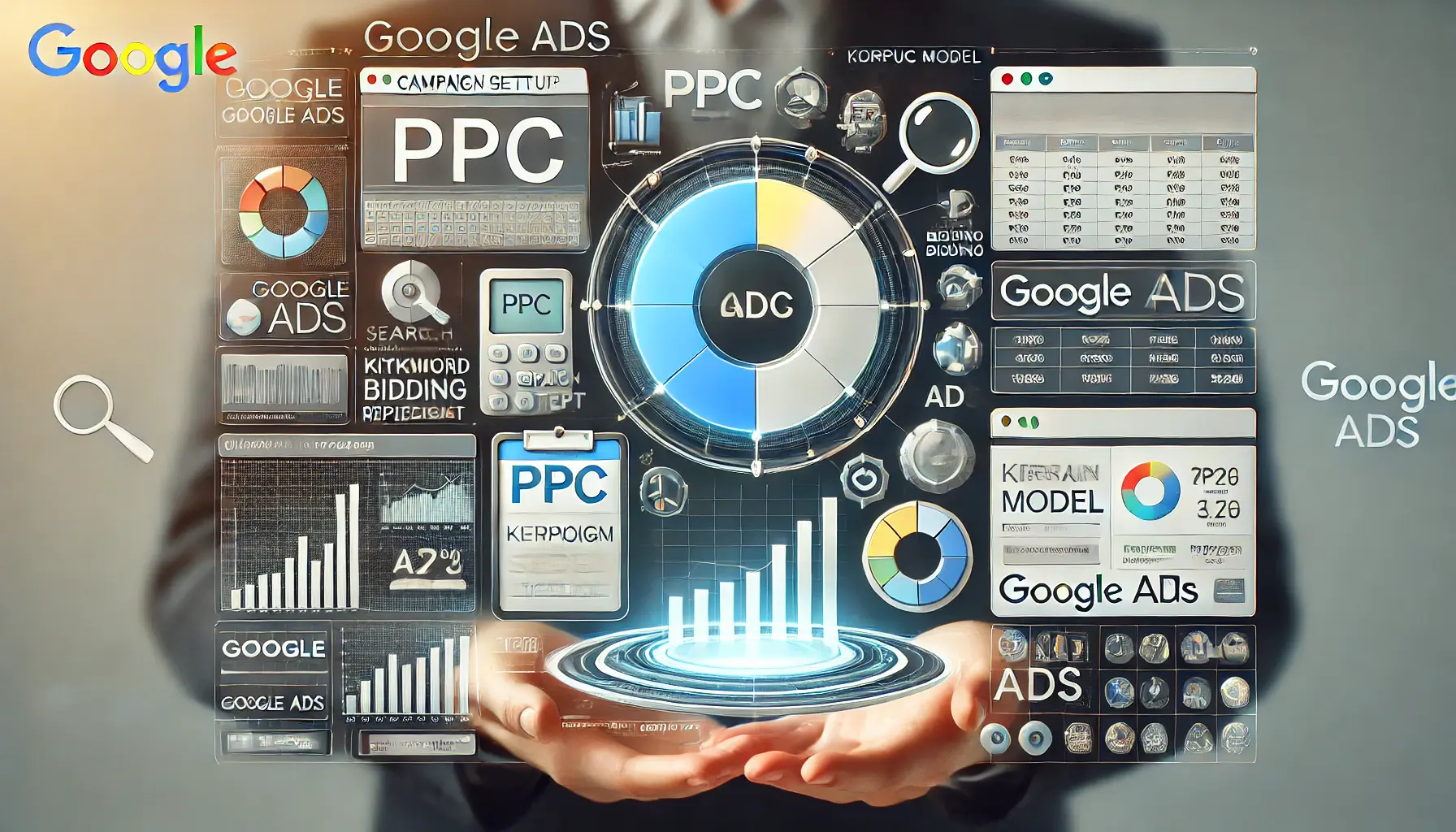
Illustration of the foundational aspects of Google Ads, highlighting PPC models and campaign setup tools.
Comprehending the Basics of Google Ads
At its core, Google Ads functions as a pay-per-click (PPC) system, where advertisers bid on keywords to secure ad placements.
The structure of Google Ads is hierarchical, comprising accounts, campaigns, ad groups, keywords, and ads.
This layered approach enables precise targeting and management, ensuring businesses can align their advertising efforts with specific objectives.

Illustration of keyword targeting and match types in Google Ads, highlighting strategic keyword use and targeting analytics.
Keyword Targeting and Match Types
Keywords are the cornerstone of Google Ads campaigns.
Mastery of match types—broad, phrase, and exact—allows advertisers to specify how and when their ads should serve.
Effective keyword research and routine keyword list optimization ensure that ads are shown to the right audience while irrelevant traffic is excluded.

Illustration of how bidding strategies and Ad Rank impact ad placement and performance in Google Ads.
Leveraging Bidding Strategies and Ad Rank
Ad Rank determines the position and visibility of ads, influenced by factors such as bid amount, ad quality, and the impact of ad extensionsAdditional information, such as links or contact details, that can be added to ads to enhance visibility and engagement..
By selecting appropriate bidding strategies, like Target CPA or Maximize Conversions, businesses can optimize their ad spend and achieve better results while maintaining efficiency.
Implementing Conversion Tracking and Performance Optimization
Accurate conversion tracking is critical for evaluating the success of campaigns.
Configuring conversion actions and implementing the Google tag provide insights into user behavior.
Performance optimization strategies, such as refining ad copy, enhancing landing pages, and using automated bidding, can significantly improve campaign outcomes.

Illustration of advanced campaign types in Google Ads, emphasizing multi-channel ad strategies and AI optimization.
Utilizing Advanced Campaign Types
Performance Max campaigns, powered by AI, enable advertisers to reach audiences across multiple platforms.
By providing high-quality creative assets and setting clear conversion goals, businesses can expand their reach and optimize performance seamlessly.

Illustration of key strategies for success in Google Ads, highlighting analytics, planning, and optimization tools.
Key Strategies for Success
To maximize the potential of Google Ads, consider these strategies:
- Regularly review and refine your account structure to ensure alignment with business objectives.
- Ensure keywords and ad copy are optimized for relevance and user engagement.
- Apply advanced bidding strategies and monitor performance metrics to drive data-informed decisions.
- Use conversion tracking to effectively measure the success of your campaigns and help drive future strategies.
Mastering how Google Ads works is a mix of both technical understanding and strategic application.
By applying the insights in this article, your business can build effective campaigns that optimize return on investment and secure ongoing success in the digital marketplace.
From keyword targeting to performance tracking, mastering the mechanics of Google Ads empowers businesses to create effective campaigns that drive meaningful results.

Illustration representing inquiries and solutions related to Google Ads, showcasing analytics and targeting features.
Your campaigns can be managed by an agency specialized in Google Ads, check out our service page.
Commonly Asked Questions About How Google Ads Work
Understanding how Google Ads works can be quite complicated.
Here are some common questions to help explain how Google Ads works in detail.
Google Ads is an online advertising platform where businesses bid on keywords to display ads.
It operates on a pay-per-click model, charging advertisers when users click their ads.
When a user searches, Google runs an auction to determine which ads appear.
Ad Rank, based on bid amount and Quality Score, decides ad placement.
Ad Rank is determined by bid amount, ad quality (relevance and expected click-through rate), and the impact of ad extensions.
Keyword match types—broad, phrase, and exact—control how closely a user’s search must match your keyword for your ad to appear.
Negative keywords prevent your ads from showing on searches with specific terms, helping to exclude irrelevant traffic.
Set up conversion tracking by creating a conversion action in your account and installing the global site tag on your website.
Google Ads provides strategies like Target CPA, Target ROASA bidding strategy that optimizes for a predetermined return on ad spend., Maximize Conversions, and Manual CPC to align with different campaign goals.
Quality Score determines ad eligibility and cost.
Stronger Quality Scores can result in better ad positions at lower costs per click.
Ad extensions provide additional information, such as links or contact details, enhancing ad visibility and click-through rates.




